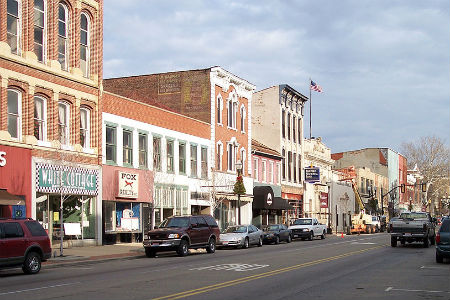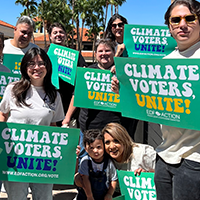Close to home: Five key questions from local leaders about the impact of EPA budget cuts

By Elgie Holstein, Director of Strategic Planning
Next week President Trump is expected to release his full budget. This follows the “skinny budget” released in March, although given the harm it would do to the health of our families and the welfare of our communities, perhaps calling it the “skeleton budget” would be more appropriate. While this reckless proposal takes an axe to most departments of the government, he singled out the Environmental Protection Agency for the most damaging cuts.
What the President might not understand, or perhaps hoped that no one would notice, is that much of EPA’s budget ends up being spent in states, cities, and rural areas, helping to keep all Americans healthy and safe.
It was that local-level impact about which I heard a lot when I met with a bipartisan group of local officials as part of the National Policy Institute on Energy, Natural Resources, and Climate Change put on by the National Association of Latino Elected Officials (NALEO). These incredibly talented, smart and in many cases young Latino leaders are the front lines, and they are being short-changed by this Administration.
Here is a snapshot of some of the thoughtful, hard-hitting questions I received regarding the role of EPA in local communities, from the people who see it most acutely.
-
“My community has terrible air quality on hot summer days. Our county monitors this with funds from EPA, and we receive a warning through the media when the air is so polluted that children and the elderly are advised to stay inside. If EPA stops paying for air monitoring, will our community have to find these funds on our own?”
Nationally, EPA picks up the tab for an average of about 25% of state and local air quality monitoring costs. Why does that work matter to local officials? Because on those “Code Red” days, air quality monitoring tells local officials whether young children with asthma and senior citizens with heart disease should stay indoors
Without EPA funding, states will have to either come up with the additional funds themselves, or fall short of performing their public health obligations under the federal Clean Air Act
-
“I live in a town that we are trying to re-develop economically, and one of the things that would be extremely helpful for that effort is a bridge to connect two of our neighborhoods. We are working through that process now, but the project requires environmental permits. Will this budget prevent my town from getting needed infrastructure?”
The Trump budget would slow down – not speed up – environmental permitting. First, he is proposing to close down a number of EPA’s local and regional offices. So, there will be fewer people to help process those permits. In addition, proposed cuts to the Department of Transportation will hamper efforts to develop all kinds of new transportation projects.
-
“I represent a coastal community. We are dealing with “sunny day” flooding on a regular basis, and we have many infrastructure needs to help us address the changing climate. Will the federal dollars we need to do this work still be available?”
Unlikely. The President and his new EPA chief, Scott Pruitt, have made it very clear that they aren’t going to lift a finger in the fight against climate change – they say they don’t accept the science behind it. As a result, they plan to cut every cent from EPA’s budget that has been going to fight climate change – including the Obama Administration’s landmark Clean Power Plan.
While the President keeps talking about his plan to have an infrastructure package, whenever he finally releases that proposal it is doubtful that it will offer any support for communities fighting to protect themselves from climate change impacts.
-
Our local government budgets are tight. Can we count on EPA to continue its environmental enforcement work?”
Not if the President’s budget is approved. Many Americans aren’t old enough to remember the days when polluters simply opened their factory tanks and dumped their chemical wastes into rivers and lakes, or sometimes onto the ground. Nowadays, such polluting is highly illegal. But if we don’t have the EPA as the “environmental cop on the beat,” it will make it that much harder for local governments to keep their air and water safe from unscrupulous “midnight polluters.
-
“I represent an old industrial area that has a number of heavily polluted sites we need to get cleaned up. Will EPA still be able to work with those of us in local governments who want to clean up toxic sites?
In communities across the U.S., families are threatened by industrial hazardous waste, radioactive materials, and toxic chemicals such as lead, asbestos, and dioxin – compounds that cause cancer, reproductive harm, and other damaging health impacts. There are hundreds of thousands of contaminated sites nationwide. Some of the sites – about 1,700 nationally — are so dangerous that they pose serious threats to human health, including by contaminating groundwater.
EPA plays a critical role in assessing such sites and in helping design and fund the clean-ups. Unfortunately, the Trump Administration has announced that it wants to slash about a third of such funding, which would fundamentally compromise EPA’s ability to aid communities facing such environmental threats.
In addition to the health effects, these sites pose economic risk. The longer such sites remain unaddressed, the harder it becomes for local governments to economically re-develop. Real estate values fall and businesses go looking for cleaner, more livable places to do their work and to hire employees.
In the weeks and months ahead, we will learn more about the fate of the federal environmental budget. EDF will continue to highlight the important role the EPA plays in protecting the health of our families and communities. You can learn more about the EPA’s work in local communities and get involved in protecting and defending the EPA’s mission on our new resources page.



